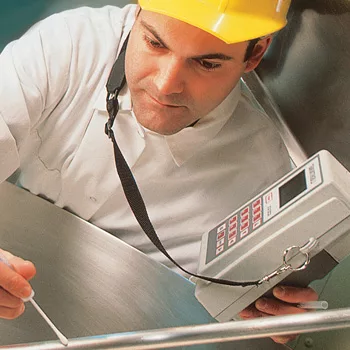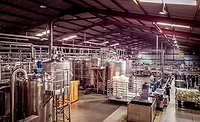Environmental Monitoring Key to Quality

A key component of every food processor’s quality program is environmental monitoring. The number of choices available to accomplish this goal can be overwhelming, but one thing is clear: the rapid detection of contaminants is critical and allows for immediate corrective action to avoid product contamination. Because of the importance of adenosine triphosphate (ATP) testing in an environmental monitoring program, selection of an accurate and reliable ATP system is essential. Not all ATP systems are alike, and many have inherent limitations to their swab and instrument design, which adds variability to the testing results.
Emphasis on Accuracy
Accuracy is fundamental in the LIGHTNING MVP® from BioControl Systems, an ATP bioluminescence monitoring system. The instrument is designed to be taken on the plant floor as the ability to withstand temperature variation, vibration and humidity—which can affect results—is built into its rugged design.
For the system to provide accurate and valid results, the instrument and sampling device (the key components of every ATP system) work together. This instrument is optimized to the specific chemistry contained in its sampling device, so that readings are accurate and consistent. The system also includes external calibration standards for high and low levels of light output that can be used to validate that the instrument is properly calibrated, or recalibrate if necessary. Positive controls are also available to verify the efficacy of the sampling device, assuring the accuracy of the entire system.
Additionally, this system has been designed to accurately report results from all surface types, including those containing residues left by cleaning or sanitizing chemicals. Some sanitizers can interfere with the ATP reaction by quenching the fluorescent signal, resulting in low readings, and potentially generating “false negative” results. The instrument contains a reagent chemistry that neutralizes the effect of sanitizers, ensuring accurate and consistent readings across all surface types and conditions.
Training and Certification
Training sanitation or quality assurance employees on the proper use of ATP instrumentation, sampling techniques, analysis and trending software, etc., is essential to the success of any program, especially one that derives its value from trending. Training of staff can be challenging, as the training must be accessible to all staff on all shifts and, if there is turnover, must be available quickly. BioControl has recognized training as a key success factor and has developed on-line training and certification for the LIGHTNING MVP system. This training can be accessed 24/7 through the company’s training Web site. Users can choose to take an on-line quiz upon completion of the training to receive certification, allowing for regular and consistent retraining and documentation for HACCP compliance and ensuring that a plant’s hygiene monitoring program runs smoothly and efficiently.
In addition to measuring ATP levels on surfaces of clean-in-place rinse-water systems, this monitoring system also has the ability to measure and record sanitizer or cleaning chemical concentration levels, pH, temperature and conductivity. The test results are automatically saved on the instrument and easily uploaded for storage and analysis. A plant may use one or all of these measurement capabilities, depending on its needs.
Not only can a multi-parameter monitoring tool increase a plant’s efficiency, it can also save money through one of its measurement parameters, the ability to measure sanitizer and cleaner concentrations. Using sanitizing and cleaning chemicals at the correct concentration is vital to their efficacy. Regardless of how well trained an employee is, traditional measurement technologies for chemical concentration have drawbacks that affect accuracy. Inaccuracy can create a food safety issue when a solution is too dilute and a cost-containment issue when a solution is too concentrated.
Titration kits and test strips require subjective interpretation of a color change and therefore are only accurate to ±25%, resulting in under-mixed solutions and causing the cleaning or sanitizing solution to be ineffective. Conversely, over-concentrated solutions waste chemicals. With sanitizing and cleaning chemicals being such a large budget item, overuse of even 10% amounts to a significant, unnecessary expense.
The method available with this monitoring system utilizes conductivity to ascertain solution strength. Because conductivity increases in a linear fashion as concentration increases, the method can be used to derive highly accurate concentration measurements. To perform measurements using this method, a reusable electronic probe is calibrated by reading both an “ideal” sanitizer or cleaning mixture and the water used to dilute the concentrate, thus establishing a baseline. Subsequent chemical solutions are then compared to this baseline and readings reported in parts per million. The concentration readings taken by this method are accurate to ±5%, a significant improvement over the accuracy of strips or titration kits.
The LIGHTNING MVP is an ATP system designed to meet the most rigorous requirements of food processors. BioControl’s approach to designing accuracy and reliability into each component of this system, combined with the system’s multifunctional aspects, makes it an accurate and reliable solution for any environmental monitoring program.
www.biocontrolsys.com
Looking for quick answers on food safety topics?
Try Ask FSM, our new smart AI search tool.
Ask FSM →






.webp?t=1721343192)
